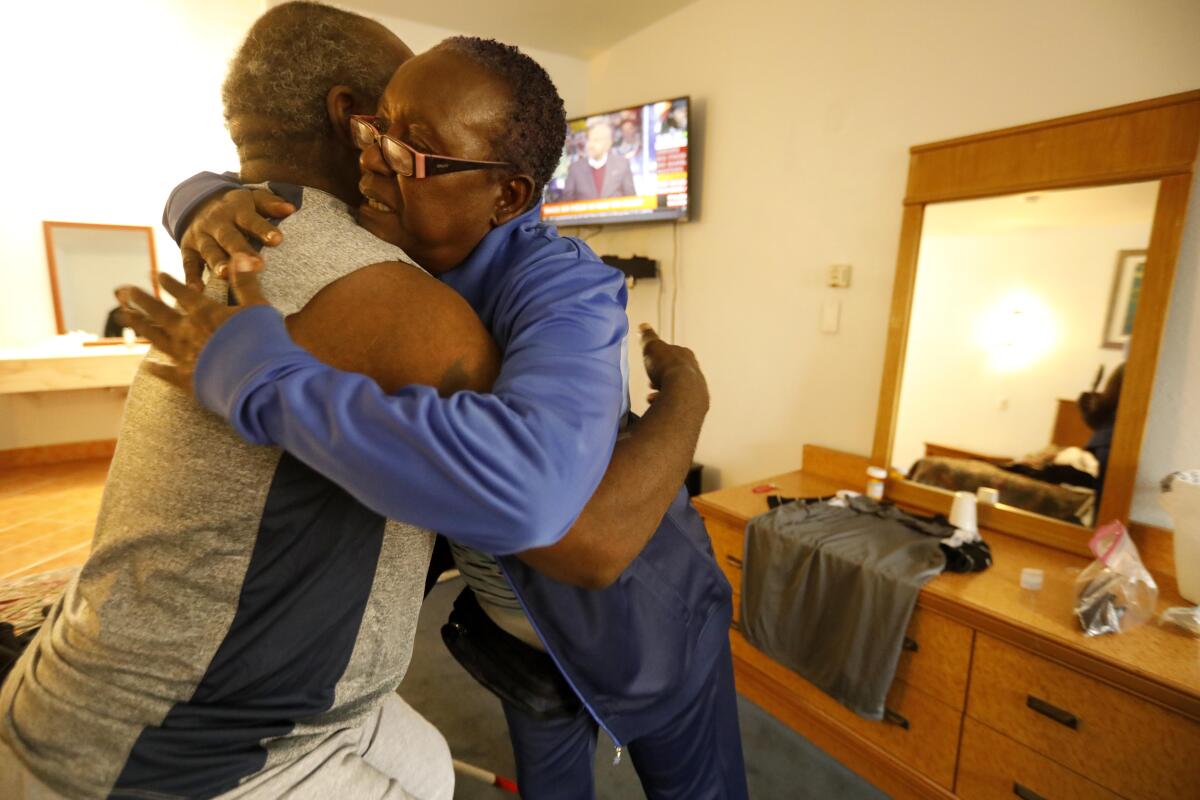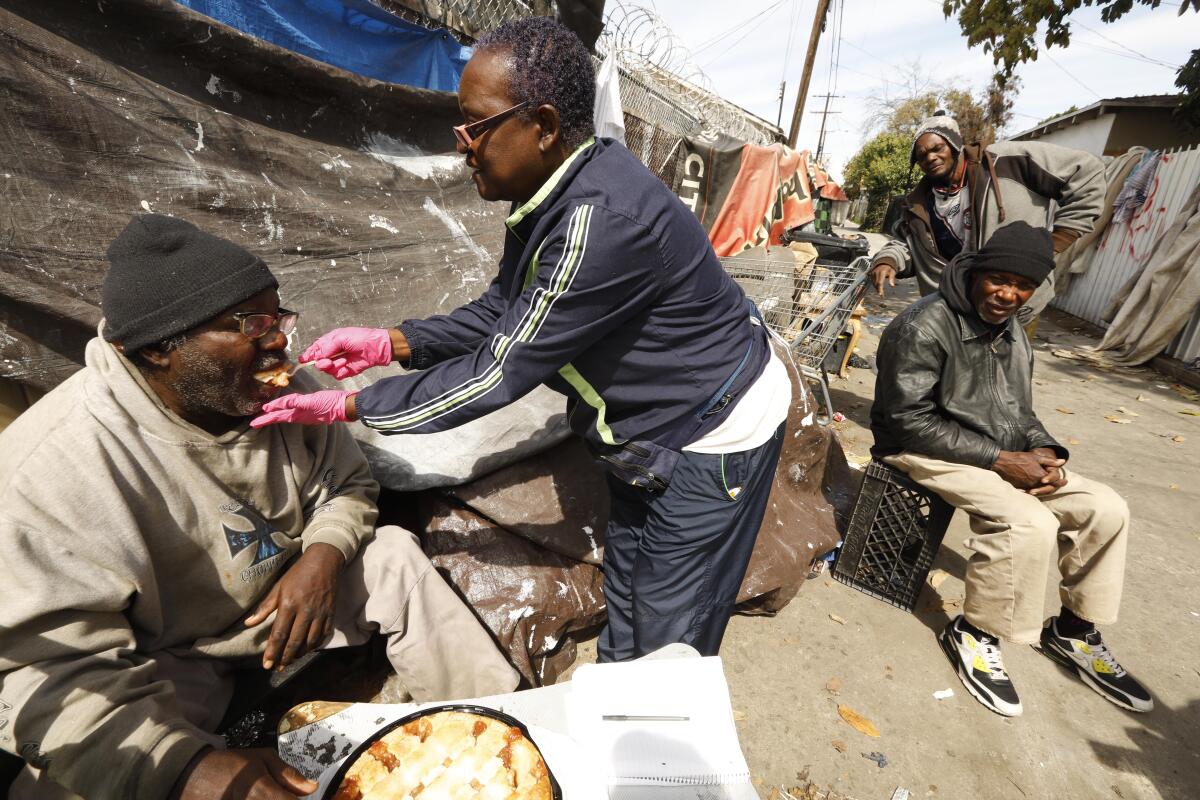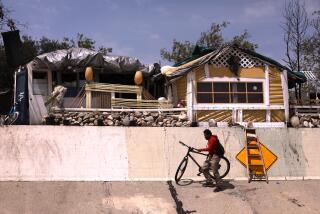Column: Why not use pandemic-emptied buildings as homeless shelters? One woman is trying

“Mama. That’s what they call me.”
Rose Rios lets her words trail off to wave at a man approaching her Mid-City home. His name is Salvador, and he’s one of the many Angelenos she has helped get off the streets and into housing as the founder of Cover the Homeless Ministry.
For more than a year, he lived in her guest bedroom. Rios took him in after finding him in a tent, suffering from the aftereffects of a stroke, including temporary blindness.
“She Mama,” Salvador told me, as if on cue, before strolling away. He has his own apartment now. “The Mother Teresa of this country.”
But unofficial sainthood is not what Rios is seeking.
Looking around at what she sees as a glut of buildings emptied by the COVID-19 pandemic, and considering the skyrocketing need for housing in an economy that’s pushing people into homelessness, Rios is telling everyone who will listen that she plans to buy a vacant building in South L.A. and turn it into a shelter.
“God spoke to me and told me, ‘You know, what? Just get a building,’” she said.
Of course, that’s easier said than done. Land is expensive in Los Angeles, even during tough times. So are buildings and remodeling, and environmental remediation and legal fees to navigate cumbersome regulations. And that’s all before getting to the cost of staffing a homeless shelter and providing services.
So far, Rios said she is soliciting donations from churches and has about $200,000 — a fraction of what’s likely to be the ultimate price tag.
Get the latest from Erika D. Smith
Commentary on people, politics and the quest for a more equitable California.
You may occasionally receive promotional content from the Los Angeles Times.
“I don’t even know what house that would get you,” said Ryan Patap, director of market analytics at CoStar Group. He noted that a run-down, six-unit apartment building in the neighborhood Rios is eyeing just sold for $900,000.
Rios isn’t cowed, though.
Patap acknowledged that $500,000 is probably the bare minimum of what she would need to buy a property that could work as a homeless shelter. And L.A. City Councilman Curren Price told me that he intends to kick in another $300,000 in city funds, given that the shelter would probably go in his South Los Angeles district.
But that additional funding could depend on whether he and other council members can resurrect a spending plan that Mayor Eric Garcetti has rejected. It would use $88 million slashed from the Los Angeles Police Department’s budget on initiatives in Black and Latino communities. Price’s district would get about $21 million of that.
“She doesn’t have a harebrained scheme,” he said of Rios. “She has demonstrated great skill and creativity in getting support and has been able to do it using limited resources.”
Whatever happens, her pitch does raise important and, so far, largely unaddressed questions of what Los Angeles will do in the coming post-pandemic world, in which the experience of gathering in buildings — whether to go work in an office or to see a movie in a theater — could be forever changed.
“Yes, we are going to be going back to the office, but it’s going to be different. I think that will mean we’re going to need less office space,” Patap said.
Still, he added that “there’s just a lot that remains to be seen in terms of how office and retail [space] will be used and how we come out of this pandemic.”
Will we be a city with mostly empty buildings and people sleeping on the ground outside them? Salesforce has already put this fear into San Francisco.
The tech giant, which owns or leases five buildings in downtown San Francisco, including the tallest skyscraper, announced this month that its 10,000 or so employees will be able to work from home indefinitely. Eventually, most will have the option of coming in one to three days per week.
“An immersive workspace is no longer limited to a desk in our Towers,” the company declared. “The 9-to-5 workday is dead.”
Instead, Salesforce says it will be “reimagining” its offices as “community hubs.” It joins a slew of other tech companies, including Dropbox, Slack, Pinterest, Twitter and Yelp, that have announced they won’t return to pre-pandemic, in-office norms.

Of course, South Los Angeles is not South of Market in San Francisco.
It’s home not to gleaming office buildings but to dense streets dotted with small shops that could survive in a post-pandemic world by serving locals, as well as industrial buildings that are in high demand now and probably will continue to be, Patap predicted.
Nevertheless, Rios has watched in alarm for the last year as poverty-driven homelessness has seemed to spill ever further into the streets of South L.A. And for the first time in 25 years, she has felt largely helpless to stop it, because the COVID-19 pandemic forced her to scale back the already bare-bones operations of Cover the Homeless Ministry.
She runs the ministry alone out of her Mid-City home, with help from a few volunteers and funding from local churches and Price’s office. A former employee of the L.A. County Department of Public Social Services, Rios focuses on helping homeless people navigate the bureaucratic maze necessary to get housing, but as she did with Salvador, she often gets more directly involved.
In the days before the coronavirus, Rios would drive around South L.A., wearing her signature tracksuit and sporting her close-cropped purple hair. She’d strike up conversations with homeless people, pass out food and hotel vouchers, and take them where they needed to go.
“We was picking them up and taking them to the doctor. But we had to stop doing that,” said Rios, who, in her 70s and Black, is at high risk for COVID-19. “Now we just give them resources.”
There is some hope. Funding for Project Roomkey, the initiative to move the most vulnerable homeless people off the streets and into hotels and motels, was recently extended by the Biden administration. But it isn’t going to last forever.
All signs point to the economy not recovering evenly after the pandemic, exacerbated by decades of racist housing policies that have left a disproportionate number of Black Angelenos homeless and many more Latino residents living on the brink of it.
For Rios, who grew up near East 55th Street and Central Avenue in South L.A., not far from where tents of Black and Latino men and women now line the blocks, what’s happening is personal.
“They got to open up some of these vacant buildings that’s been sitting there since I was a kid,” she said. “They got to.”
More to Read
Get the latest from Erika D. Smith
Commentary on people, politics and the quest for a more equitable California.
You may occasionally receive promotional content from the Los Angeles Times.











